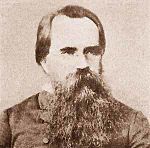Alexander Kovalevsky facts for kids
Quick facts for kids
Alexander Kovalevsky
|
|
|---|---|

Alexander Kovalevsky
|
|
| Born | 7 November 1840 Vārkava, Vitebsk Governorate
|
| Died | 1901 |
| Nationality | Russian |
| Citizenship | Russian |
| Alma mater | University of Heidelberg |
| Known for | Gastrulation |
| Scientific career | |
| Fields | Embryology |
Alexander Onufrievich Kovalevsky (born November 7, 1840, died 1901) was an important Russian scientist. He was an embryologist, which means he studied how living things develop from tiny embryos. Kovalevsky went to medical school at the University of Heidelberg and later became a professor at the University of St Petersburg. His brother, Vladimir Kovalevsky, was a paleontologist (someone who studies fossils). His sister-in-law was the famous mathematician Sofya Kovalevskaya.
What Did Alexander Kovalevsky Discover?
Kovalevsky made some big discoveries about how animals develop. He showed that all animals go through a special early stage called gastrulation. During gastrulation, the embryo starts to form different layers of cells. These layers will later become all the different parts of the animal's body.
One of his most famous discoveries was about sea squirts, also known as tunicates. Before Kovalevsky, scientists thought tunicates were a type of mollusc (like snails or clams). But Kovalevsky looked closely at their larval stage, which is like a baby tunicate. He found that these larvae had a notochord and gill slits.
- A notochord is a flexible rod that supports the body.
- Gill slits are openings in the throat area.
These features are also found in vertebrates, which are animals with backbones (like fish, birds, and humans). Kovalevsky showed that the notochord and gill slits in tunicates developed from the same cell layers as they do in vertebrates. This meant that tunicates were actually more closely related to vertebrates than to molluscs!
Because of Kovalevsky's work, tunicates were grouped with vertebrates into a larger group called chordates. This discovery helped scientists understand how different animals are related through evolution. It showed that studying how embryos develop (embryology) could help explain the evolutionary history of life.
See also
 In Spanish: Aleksandr Kovalevski para niños
In Spanish: Aleksandr Kovalevski para niños



